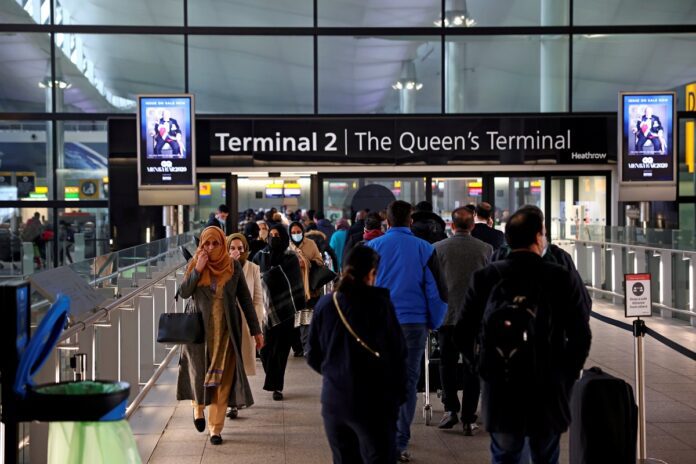Breaking News
International flight relocation, Anguish, chaos, gridlock sets in
“Given the right support and leverage, they will find a path forward to solve these embarrassing problems. But we should all brace for a lot of pain, any which way. And no, the terminal is not by any stretch of imagination, a 14 million passengers terminal. It is a head scratcher for us all to see how to make the best of it.”

International travellers, airlines will in the coming days experience pains, gridlock along with discomfort while embarking on their travels both outbound and inbound.
This is coming at the heel of the relocation of international airlines and travellers to the new international airport, terminal two, in Lagos.
It would be recalled that the Minister of Aviation and Aerospace Development, Festus Keyamo, last month, directed all international airlines to vacate the Murtala Muhammed International Airport, MMIA, from October 1, 2023.
Keyamo notified the airlines to commence immediate action of the relocation of their tickets sales offices to the new terminal two constructed by the Chinese consortium for the commencement of renovation work at the MMIA.
The announcement has thus led to chaos for both travellers and airlines, as they struggle to manage operating in the new terminal which capacity is far less than the current (old) terminal.
One of causes of the chaos is the new terminal inability to accommodate big planes in the range of the Boeing 777 and above, as the jetbridges installed can only take small planes. Aviation World during a visit to the airport witnessed gridlock of tavellers as they queued along the taxi way with their luggage waiting to be called up to check-in.
However, the Chief Operating Officer, Ibom Air, Gearge Uresi, in a chat, disclosed that the new terminal is nowhere near 14 million passengers capacity. He stated that the new terminal actually has far less capacity than the current (old) terminal. He said: “You do not just dream up these things. The ‘old’ terminal, launched in 1979, was designed with a capacity to process 1.5 million passengers per annum.
“At full stretch, sweating the asset, it would struggle to process three million passengers.
“Its peak hour processing capacity for both departing and arriving passengers was 1,200. So its design service level was to provide comfortable processing for 1,200 departing and 1,200 arriving pax at peak hour.
“These numbers informed the design of circulation space, check in counters, toilet facilities, access and egress doors into and out of the terminal, the specifications of the baggage belt systems and arrival carousels (capacity and strength), the passengers security screening and customs/immigration capacity, any lifts and escalators, the scope and placement of commercial offerings and of course the access and egress road system as well as vehicle parking capacity.
“With time and without an active Master Plan for improving the airport as numbers grew, the throughput began to surpass the processing capacity of the terminal by far.
“As at 2012, actual peak hour traffic was 4,100 departing passengers and the same for arriving passengers. Also, the arrival peak had stretched to a daily 2.5 hour period while the departing peak had stretched to a daily 3.5 hour period (due to gridlock from lack of adequate processing capacity), thereby stretching the terminal to breaking point.
“The check-in area and arrivals carousel areas were a total mess, every night.
“To alleviate this while planning for new terminal capacity, we decided to expand the terminal at both ends to create additional processing capacity for customs/immigration as well as security screening for departures and arrivals, including a whole new set of three high capacity baggage carousels each at both ends.
“Even though this expansion eventually got badly built, it nevertheless came as a huge relief to the terminal. Otherwise that terminal wouldn’t have survived till today.
“As that was going on, we briefed the same airport architects who had helped design Cape Town
International’s 15 million passengers terminal to do the conceptual design for a new, 24-airbridge, 9-million passengers, modularly expandable international terminal that was to be situated on the left side of the current (old) terminal.
“It was this conceptual design that we took to China Exim Bank and that they thoroughly interrogated and accepted before approving the facility they were to give us.
“But we started building a terminal, totally different from the one we conceptually designed in the opposite location from where we were meant to build it.
“Unfortunately, every element of basic terminal design was stood on its head in the design of this terminal. The basic principles that inform terminal design from scratch, are: How many passengers are you designing a terminal for and for what purpose? Is the terminal being built for international, domestic or both and is it to facilitate flight connections or just origin and destination traffic?
“These then determine how the key elements are designed in, including how many contact and remote aircraft stands would be required and the accompanying circulation space, check in capacity, security screening and customs/immigration capacity, toilet facilities, etc required for optimal processing of the design numbers of passengers at peak.
“Of course depending on the requirements of the airport operator, how much commercial offerings and support services such as lounges etc would then need to be designed in.
“The design thread carries all the way from Landside to airside, fitting in with the Landside access and egress system, the access and egress doors into and out of the terminal, as well as the entire airside maneuvering system.
“The design goal is always to deliver an efficient, fit-for-purpose infrastructure for optimal processing. Only after these considerations are accommodated, do you then add ‘aesthetics’ to the mix.
“It is a head scratcher to see a terminal of this size built with a single pier of six connecting stands, a study in terminal design anomaly. The immediate past aviation Minister, Hadi Sirika, and the FAAN team invested considerable energy, efforts and resources to surmount the gigantic problems brought about by this wrongly positioned and badly designed terminal. “Their efforts have remained largely unseen and unheralded. But they were laudable.” He further stated that one of the things they got right about the terminal was the modern aesthetics.
“The good thing is that the authority has a serious and committed managing director and the airport has a pragmatic General Manager at the moment.
“Given the right support and leverage, they will find a path forward to solve these embarrassing problems. But we should all brace for a lot of pain, any which way. And no, the terminal is not by any stretch of imagination, a 14 million passengers terminal. It is a head scratcher for us all to see how to make the best of it.”
Travellers’ ordeal
Meanwhile, travelers have continued to express their dismay about the situation.
One of the travellers who pleaded anonymity, told Aviation World that this is worst time to fly out of Nigeria.
“The international airport situation is chaotic. So we switched to the new terminal and this is happening? Wasn’t these shortcomings put into consideration during the planned switch.”
The General Secretary, National Union of Air Transport Employees, NUATE, Ocheme Oba, said: “The pains the passengers are going through are unfortunate. Sometimes we transfer our frustrations caused by sudden dislocation from our comfort zones to vulnerable people.
“Yes, there are no jetbridges. Apart from the passengers not being transported with adequate type of buses to and from the aircraft, the new terminal, on paper, ought not be the source of these pains.
“It is facts like these, that give confidence that with attention to detail, they will overcome the chaos as soon as possible.”
FG sets up task force
Meanwhile, Keyamo has set up a task force to resolve these challenges within the shortest possible period.
Spokesman for the Minister, Oluseyi Odutayo in a statement said, “We urge all passengers and other stakeholders to be patient and bear with us as the inconvenience caused will soon be resolved. Your understanding plays a vital role in making this transition smoother for everyone involved.
“The primary objective of this task force is threefold; resolve passenger concerns as the task force is expected to work diligently towards resolving all concerns raised by passengers regarding congestion, discomfort, and related issues stemming from terminal relocation. We are committed to ensuring that every passenger’s voice is heard and addressed promptly.
“Others are to minimise discomfort by dwelling on minimizing any form of discomfort during this transition period, streamlining processes at both terminals while closely monitoring operations 24/7, enhanced signage, dedicated support staff, and improved communication channels will be implemented proactively.”
“We pledge transparency throughout this process by providing regular updates on progress made in addressing concerns arising from airline relocations. FAAN aims at improving public relations strategies through various channels including online platforms and customer service helplines so that you stay informed about developments firsthand.”




















